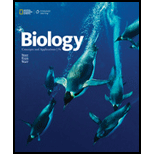
Concept explainers
Introduction:
Genes are a functional unit of heredity. They are passed on from parent generation to the progenies. Genes consist of DNA sequences that pass on specific information regarding cellular functioning. Genes are responsible for the synthesis of different types of proteins that perform the required function in the body.
Answer to Problem 1SQ
Correct answer:
The expression of a gene may depend on the type of organism, environmental conditions, and the type of cell. Hence, the correct answer is option d.
Explanation of Solution
Reason for correct answer:
Option d. is given as “all of the above.”
Gene expression depends on the type of organism. Some genes (such as insulin coding genes) are active in only a few animal species. Specific types of cells secrete certain proteins. Some of the hormonal proteins are secreted under specific environmental conditions. Gene expression depends on various factors, such as the type of organism, cell type, and environmental conditions.
Reason for incorrect answer:
Option a. is given as, “the type of organism.”
Not all the genes are expressed in all the organisms. Expression of genes depends on the type of organisms. Along with this, certain specific genes are expressed only in specialized cells. This makes the expression of genes dependent on the type of cell as well. Hence, option a. is incorrect.
Option b. is given as, “environmental conditions.”
Genes coding for certain hormonal proteins are expressed under specific environmental conditions. Not all the hormones are secreted in all species. This also makes gene expression dependent on the type of organism. Hence, option b. is incorrect.
Option c. is given as, “type of cell.”
Some genes are secreted in specific types of cells, for example, oncogenes are active only in tumor cells. Under certain environmental conditions, also, particular genes are activated. Hence, option c. is incorrect.
Hence, the options a., b., and c. are incorrect.
The type of organism, environmental conditions, and the type of cell, all determines the expression of a gene in an organism. Thus, the correct option is d.
Want to see more full solutions like this?
Chapter 10 Solutions
Biology: Concepts and Applications (MindTap Course List)
- Skryf n kortkuns van die Egyptians pyramids vertel ñ story. Maximum 500 woordearrow_forward1.)What cross will result in half homozygous dominant offspring and half heterozygous offspring? 2.) What cross will result in all heterozygous offspring?arrow_forward1.Steroids like testosterone and estrogen are nonpolar and large (~18 carbons). Steroids diffuse through membranes without transporters. Compare and contrast the remaining substances and circle the three substances that can diffuse through a membrane the fastest, without a transporter. Put a square around the other substance that can also diffuse through a membrane (1000x slower but also without a transporter). Molecule Steroid H+ CO₂ Glucose (C6H12O6) H₂O Na+ N₂ Size (Small/Big) Big Nonpolar/Polar/ Nonpolar lonizedarrow_forward
- what are the answer from the bookarrow_forwardwhat is lung cancer why plants removes liquid water intead water vapoursarrow_forward*Example 2: Tracing the path of an autosomal dominant trait Trait: Neurofibromatosis Forms of the trait: The dominant form is neurofibromatosis, caused by the production of an abnormal form of the protein neurofibromin. Affected individuals show spots of abnormal skin pigmentation and non-cancerous tumors that can interfere with the nervous system and cause blindness. Some tumors can convert to a cancerous form. i The recessive form is a normal protein - in other words, no neurofibromatosis.moovi A typical pedigree for a family that carries neurofibromatosis is shown below. Note that carriers are not indicated with half-colored shapes in this chart. Use the letter "N" to indicate the dominant neurofibromatosis allele, and the letter "n" for the normal allele. Nn nn nn 2 nn Nn A 3 N-arrow_forward
- I want to be a super nutrition guy what u guys like recommend mearrow_forwardPlease finish the chart at the bottom. Some of the answers have been filled in.arrow_forward9. Aerobic respiration of one lipid molecule. The lipid is composed of one glycerol molecule connected to two fatty acid tails. One fatty acid is 12 carbons long and the other fatty acid is 18 carbons long in the figure below. Use the information below to determine how much ATP will be produced from the glycerol part of the lipid. Then, in part B, determine how much ATP is produced from the 2 fatty acids of the lipid. Finally put the NADH and ATP yields together from the glycerol and fatty acids (part A and B) to determine your total number of ATP produced per lipid. Assume no other carbon source is available. 18 carbons fatty acids 12 carbons 9 glycerol A. Glycerol is broken down to glyceraldehyde 3-phosphate, a glycolysis intermediate via the following pathway shown in the figure below. Notice this process costs one ATP but generates one FADH2. Continue generating ATP with glyceraldehyde-3-phosphate using the standard pathway and aerobic respiration. glycerol glycerol-3- phosphate…arrow_forward
 Concepts of BiologyBiologyISBN:9781938168116Author:Samantha Fowler, Rebecca Roush, James WisePublisher:OpenStax College
Concepts of BiologyBiologyISBN:9781938168116Author:Samantha Fowler, Rebecca Roush, James WisePublisher:OpenStax College Biology: The Unity and Diversity of Life (MindTap...BiologyISBN:9781305073951Author:Cecie Starr, Ralph Taggart, Christine Evers, Lisa StarrPublisher:Cengage Learning
Biology: The Unity and Diversity of Life (MindTap...BiologyISBN:9781305073951Author:Cecie Starr, Ralph Taggart, Christine Evers, Lisa StarrPublisher:Cengage Learning Understanding Nutrition (MindTap Course List)Health & NutritionISBN:9781337392693Author:Eleanor Noss Whitney, Sharon Rady RolfesPublisher:Cengage Learning
Understanding Nutrition (MindTap Course List)Health & NutritionISBN:9781337392693Author:Eleanor Noss Whitney, Sharon Rady RolfesPublisher:Cengage Learning Biology Today and Tomorrow without Physiology (Mi...BiologyISBN:9781305117396Author:Cecie Starr, Christine Evers, Lisa StarrPublisher:Cengage Learning
Biology Today and Tomorrow without Physiology (Mi...BiologyISBN:9781305117396Author:Cecie Starr, Christine Evers, Lisa StarrPublisher:Cengage Learning





